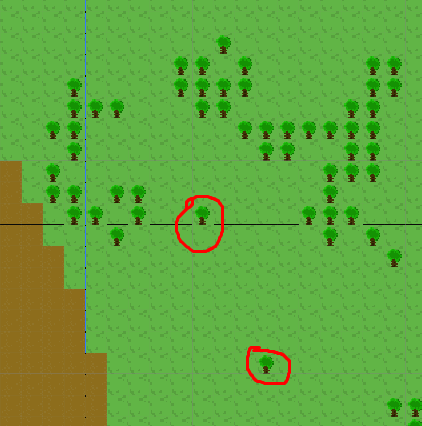- Home /
2D: Best way to group a type of tile based on their neighbors similar type?
Hello,
I currently have a tilemap structure setup using a multi-dimensional array.
TDTile[,] _tiles = new TDTile[50,50];
On this map I have a bunch of trees, and I wanna group them all by pairs of 4. This is working, but it is leaving residue trees behind, like you can clearly see nice groups of 4 or bigger tree clusters, but occasionally there are a couple tree's spread around the map that are not grouped, so in a pair, or just a single tree every here and there..
Is there a better way I can group my tiles?
Example view:

This is my current approach:
private List<TDTile> GetNeighbors(int x, int y)
{
Vector2Int[] positions = new []
{
new Vector2Int(x-1, y),
new Vector2Int(x+1, y),
new Vector2Int(x, y - 1),
new Vector2Int(x, y + 1),
new Vector2Int(x + 1, y + 1),
new Vector2Int(x - 1, y + 1),
new Vector2Int(x + 1, y - 1),
new Vector2Int(x - 1, y - 1),
};
List<TDTile> neighbors = new List<TDTile>();
foreach (var pos in positions)
{
if (IsInRangeOfMap(pos.x, pos.y))
{
neighbors.Add(_tiles[pos.x, pos.y]);
}
}
return neighbors;
}
private void GroupTilesBy(string type, int minAlive)
{
for (int x = 0; x < Width; x++)
{
for (int y = 0; y < Height; y++)
{
if (_tiles[x, y].Type == type)
{
var neighbors = GetNeighbors(x, y)
.Count(f => f.Type == type)
neighbors++; // Count our own tile in aswel
if (neighbors < minAlive)
{
_tiles[x, y] = _db.GetDefaultTile();
}
}
}
}
}
I could do something cheeky like this after grouping, to solve the problem:
for (int x = 0; x < Width; x++)
{
for (int y = 0; y < Height; y++)
{
if (_tiles[x, y].Type == type)
{
var neighbors = GetNeighbors(x, y)
.Count(f => f.Type == type)
if (neighbors == 0)
{
_tiles[x, y] = _db.GetDefaultTile();
}
}
}
}
But I feel like I'm just missing something, that I'm doing wrong in the actual algorithm.
Open to suggestions about improvement.
Thanks in advance..
Kr, Shady.
Answer by SirCrazyNugget · Jul 30, 2018 at 10:37 PM
Take a look at Procedural Map generation tutorial, https://unity3d.com/learn/tutorials/projects/procedural-cave-generation-tutorial/detecting-regions?playlist=17153 this video focuses on the Flood Fill algorithm which will help you identify the tiles and their neighbours for adding/removing these
Your answer

